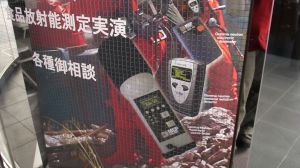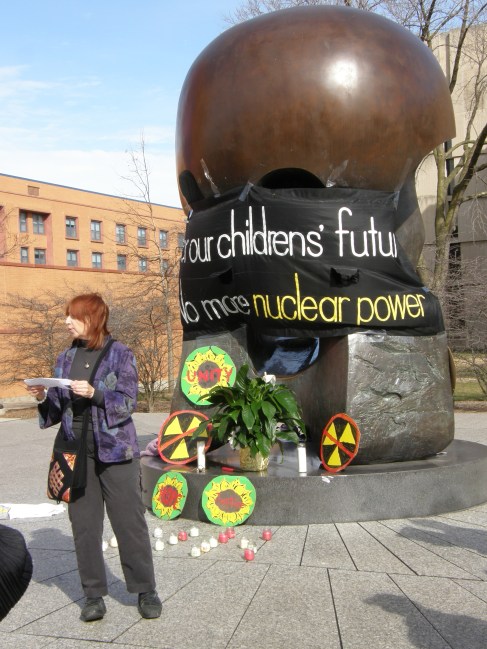My last few days in Japan were hectic. For my final presentations, I was invited along with Fukushima evacuees to present my talk on Chornobyl for two more events at the cultural center in Shimoda. The first presentation was in the afternoon expressly for the center’s board; the second in the evening and for the public. As in my previous talks in Japan during my first week in the country, the audience participated with stimulating questions and insightful observations linking Chornobyl to their own recent nuclear fallout from the damaged reactor at Fukushima after the earthquake and tsunami of March 11, 2011. There was a particular concern about whether food products from Ukraine—especially wheat, were considered safe since the time of Chornobyl. Ukrainian wheat has been the golden equivalent in grain harvesting over the centuries because it is cultivated in the unique rich dark soil called “chornozem.” However, since and despite Chornobyl which altered that natural wealth, Ukraine still continues to sell its wheat although at reduced quantities (at least in 2012).
Still the question remains—how clean is it? How clean is any of the food we eat especially after a nuclear fall-out?
I discovered how important that question was on my trip to Fukushima Prefecture after my talks in Shimoda. As before, Kazko Kawai, the director of Voices of Lively Spring, a humanitarian and advocacy group for Japan which hosted my Japan tour, kindly acted as my English translator. Despite her having a sore throat from all the public translating she was doing during the previous week on our tour, she graciously accompanied me by train to Koriyma City, Fukushima Prefecture where we conducted several interviews with Green Party politicians and to witness the post 3-11 activism in that city.
Koriyama is part of Fukushima Prefecture, but is oddly considered not as toxic as other parts of Fukushima even though it’s a mere 60 km from the Fukushima-Daiichi nuclear power plant—about the same distance Kyiv is from Chornobyl. Koriyama City has a population of 330,000 people, and suffered considerable damage in the earthquake as well as the radiation exposure. The tsunami didn’t reach there since it is inland.
Once on the train, Kawai-san and I wore facemasks. I found it very stifling to keep one on in the relentless heat (very humid there—more so than Florida much to my surprise). We noticed how many travelers didn’t bother to wear facemasks or really take any precautions and they freely ate contaminated sandwiches and drinks that were offered by the cart-lady (always an attractive young woman usually in uniform and a colorful apron who pushes a heavy cart of food items for the passengers to purchase).
Like most Japanese train stations, the one at Koriyama is very large and surrounded within a shopping mall and restaurants—there is even a huge and busy MacDonald’s. But the most interesting place to visit was the supermarket—a very modern, abundant one with people buying food on a Saturday morning as in any normal city where one hears happy piped-in music and clerks calling out their special items to the customers. The produce section was especially fascinating with rows and rows of local and lush vegetables: grapes, peaches, eggplant, leeks, squash, lettuce–all handsomely displayed in neat rows and cellophane beneath a sign that says, “We Support Fukushima Produce.”
Fukushima is farm country—many are organic farms but any store that sells fruits and vegetables must stipulate that it comes from Fukushima on the labels. In Koriyama, the people are also encouraged to support the local farmers. And not surprisingly, the lower prices of the gorgeous produce were also an enticement for shoppers although I noticed that many customers looked over the fruits and vegetables, but didn’t pack much into their shopping baskets. Maybe my camera was a deterrent.
But not all are buying the government’s insistence of supporting the local farmers. In fact, many Koriyama residents are so mistrustful of the government that they are forming grass-roots activism on many fronts. Upon our arrival in the city, protests were being organized in the town square in front of the train station for children to be relocated from the local schools. Because Koriyama is considered outside the Fukushima exclusion zone, the children will not be relocated to areas that are not contaminated.
How contaminated is Koriyama? We met with Assemblywoman Haruna Takita and her husband, Tsuyoshi who took us around the city with a set of Geiger counters: one that measured in Becquerels, the other in microseiverts. We placed them side by side on the ground in strategic places: on a marble bench, on the concrete pavement, on a curb. The numbers shot up quickly and we watched in great alarm as the readings went as high as 10.6 Becquerels.
I asked for the Geiger counters to be placed closer to where there are trees and grass instead of on the street. At Chornobyl’s nuclear power plant, I recall how our guide demonstrated how quickly the readings on his dosimeter jumped when he measured a clump of trees. In Koriyama, the trees and grass were supposedly decontaminated and thereby safe. Hardly! The Geiger counters shot up even more quickly against the bushes, than on the concrete with a reading of up to 7.1 Becquerels in a matter of seconds.
Why are people still living there?
Haruna-san and the other Koriyama activists we met told us the same thing: they all feel an enormous responsibility to stay behind and make things better for the younger generation. They became activists because their government failed them by not telling them the truth about the enormous dangers of the meltdown at Fukushima and many have joined the Green Party or were elected as politicians in order to get their voices heard.
Strange to think it was only a little more than a year since the horrible earthquake, tsunami and then the radiation meltdown occurred on March 11. We listened as the Koriyama residents related their personal stories and tragedies of the earthquake: homes demolished, fences flying, cars smashed, loved ones missing, the frantic decisions of escaping or staying behind, and certainly they were concerned about the tsunami in other parts of Japan. And then the radiation meltdown at the Fukushima power plant occurred, no one knew it was happening. Everyone was also surprised beyond belief when they did finally hear about it mostly through the Internet or word of mouth. It was yet another horrific shock because they were so focused on the devastation of the earthquake and tsunami. Many survivors are still angry and mistrustful at their government for not being honest about the radiation and telling them when it happened. They were kept in the dark and lied to, just like the Chornobyl evacuees who were told to pack for a few days because they would return—which was a blatant fabrication of course.
It is heartening to see people become proactive after such hardships. In Koriyama City, a group of housewives established a resource center, called the 3A Radiation Center where they can discuss relevant issues such as clean schools for the children, and present their opinions and demands to the legislature. They also disburse information about radioactivity, and distribute clean fruits and vegetables that were grown outside of Fukushima so that buyers have an option.
After leaving Koriyama, I was impressed and even felt encouraged by the strength and sense of purpose of the people I met there and throughout my visit in Japan. I wondered how much progress they would make before the next anniversary of 3-11.
UPDATES: In Japan Blog: Part II, the unidentified person in the photo of the press conference is the physician/activist Dr. Kitagawa. My apologies for not previously including his name.
Satoko Muraki-san, director of the Kyushu Sunflower Project and who organized the press conference I participated in (see Japan Blog: Part II) is now running for a seat in the Kitakyushu Assembly, and we send her our best wishes.
Kawai-san sent word that Shizouka, her home base which was previously clean (and where I spent several days), is burning “disaster debris”—highly toxic waste from the 3-11 disasters. We will monitor these and other events in future blogs and we send our hopes for a better 2013 to the people of Japan who are still suffering the aftereffects of March 11, 2011.
Photos: Irene Zabytko
© 2012 by Wheat Street Productions, Inc.






